

KENT CYCLIST BATTALION IN ST LAWRENCE RD, CANTERBURY, EASTER, 1916
Recognizing the superior merits of the New-Hudson Military Bicycle, H.M War Department placed large orders.
During 1916 we supplied upwards of 16,000 New-Hudson Bicycles for the British Army, in addition to large quantities for the French Government; we have also completed our sixteenth contract of one thousand bicycles for H.M Post Office. Better testimony of their sterling qualities is impossible.
NEW-HUDSONS ABROAD: New-Hudson Bicycles have established for themselves a great name all the world over, and whenever cyclists foregather, whether it be in foreign lands or in the King’s Dominions, there the New-Hudson is in evidence.
New-Hudson Military Bicycles were adopted for the Military Cycle Equipment for the East Africa Campaign. There is only one reason for this ubiquity – Merit.
– 1917 New Hudson Sales Catalogue, page 2
With 16,000 bicycles supplied in 1916 alone, New Hudson was a key supplier of military bicycles to the British government.
The Kent Cyclist Battalion, pictured here, used both New Hudson and Mk IV bicycles. You can see a New Hudson on the right in the photo above, and in the enlarged photo below second from the right (distinguishable by its chainwheel, handlebar and brake linkage).
The Kent Cyclist Battalion was formed in 1908 as part of the new Territorial Force, replacing the volunteers to form an effective properly trained and organised part-time army. The battalion was designed to defend the homeland against possible invasion when the regular army was sent overseas. The Kent Cyclist Battalion was one of the ten original territorial cyclist battalions in the country whose main role in wartime was to be in patrolling the UK coastline. This was soon changed when the regular army lost most of its manpower. The 1/1st Kent Cyclist Battalion comprised 8 companies some of which maintained small Troops in nearby towns and villages.
With no success against the Germans in the East Africa Campaign, the British re-assessed the position and, in February 1916, General Jan Smuts of South Africa took over command of the British Empire troops, and additional equipment was dispatched from England.
The introduction to the New Hudson catalogue reveals that the company supplied their military pattern bicycles for the Great War’s East Africa Campaign in 1916. As well as New Hudson bicycles delivered to East Africa, in the same year 400 BSA motorcycles were sent from England for use by the South African Motor Cyclist Corps.


1916 New Hudson Military Model No 101
War Service Pattern
Armstrong Triplex Three-Speed Gears (Optional Extra)
with Central Control
24″ Frame
28″ Wheels

This New Hudson is actually a pre-WW1 model, but identical to the company’s 1916 ‘War Service Pattern’ apart from the three-speed gears which were offered as an optional extra (other options included an Eadie coaster hub). Observe the lamp bracket fixed to the front fork; this was because the rifle fouled the lamp when it was attached to a lamp bracket in the normal place on the headstock.
This example is photographed on coastal defence duties, the role fulfilled by the Kent Cyclist Battalion.













 KENT CYCLIST BATTALION
KENT CYCLIST BATTALION
Headquarters, Drill Hall, Tonbridge, Kent
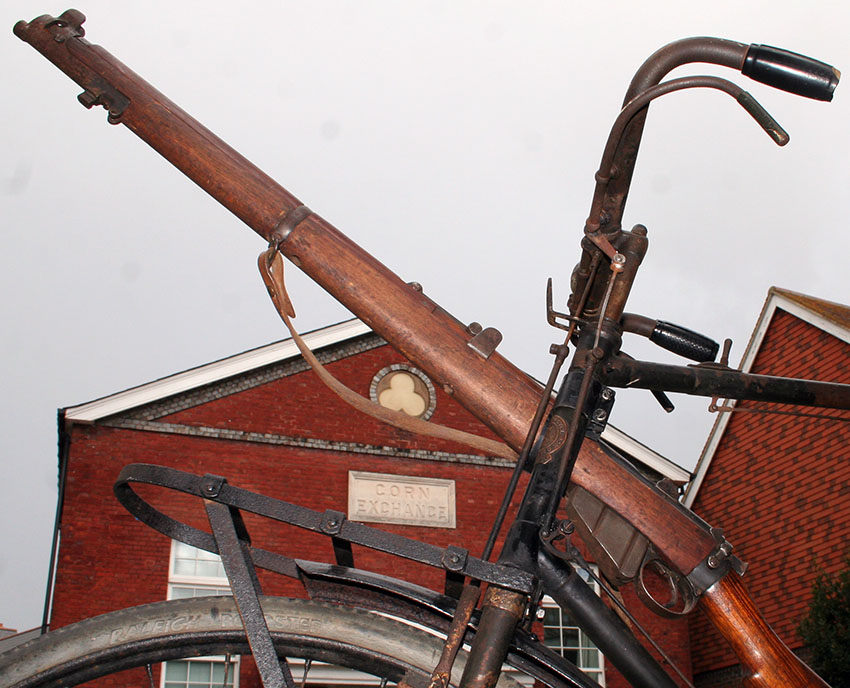
DRILL HALL, BANK ST, TONBRIDGE; PREVIOUSLY CORN EXCHANGE
PERCY James Fairbrass was born in Canterbury in 1898, second son of George Fairbrass, a platelayer on the railways. His mother Mary Ann died in 1902 aged 34, and by 1911 Percy had acquired a stepmother, Jane, at their home in St Jacob’s Place off Wincheap Road (now rebuilt as Priory of St Jacob).
On May 12, 1916, Percy, aged 18 years and three days, walked into the new Drill Hall off St Peter’s Lane (built in 1912) and signed up with the Kent Cyclist Battalion ‘for the duration of the war.’ Percy may well have seen advertisements inviting those fond of cycling to ‘cycle for the King.’ Recruits had to be at least 5ft 2ins tall, but apparently (according to this poster) ‘bad teeth no bar!’
He could not have known this would lead to his death two years later in India, recorded for posterity on a memorial in Canterbury Cathedral.
The battalion had been formed in 1908, one of ten original Territorial cyclist battalions. Recruits were part-time but took part in an annual 15-day camp and were responsible for patrolling the Kent coastline. A grant of £1 10s 6d a year was made for cycle maintenance. Surviving postcards show their rifles secure in special clips on each bike. Parade instructions were precise: a cyclist at attention will ‘grasp the left steering handle with his left hand and place the right hand at the point of the saddle, elbow to the rear.’
The cycling element, no doubt effective for running messages and patrolling Kent lanes, proved of less value in foreign battlefields. Reformed as a non-cycling infantry battalion, Percy and his colleagues left for India later in 1916.
On November 5, 1918, just six days before the end of the war, he died in the military rest station of Dagshai, not of war wounds but of pneumonia.
In 1920 a memorial tablet was placed in the military church at the nearby garrison town of Ferozepore.
It contained 41 names, including Percy’s. Other records suggest that 14 men (including Percy) died from pneumonia, 14 from “unknown disease”, four from influenza, three from fever, two from heatstroke and two from malaria. One drowned and only one died from war wounds.
– Canterbury Times, 11th June 2014. Article by David Lewis – ‘Cycling for the King’ *

1914: Above, recruits march through Tonbridge Market, near Drill Hall.
Below, Kent Cyclist Battalion members with their own bicycles, before being allocated military machines. (Observe the rifle clips on the near side rather than the offside as on their military New Hudsons and Mk IV models; also the bike on the left has a chaincase). The government subsequently issued military bicycles to encourage enlistment.

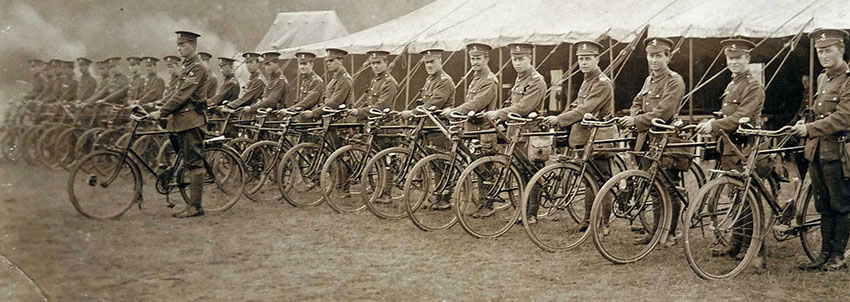
The soldiers of the Kent Cyclist Battalion wore a cap badge similar to the Royal West Kent Regiment (the invicta horse with a scroll beneath saying Kent Cyclist Battalion).
The 1/1st Kent Cyclist Battalion comprised 8 companies some of which maintained small Troops in nearby towns and villages. On the outbreak of war the 1st Line Territorial Battalion from Tonbridge was attached to the 2nd (West Lancashire) Division. It spent most of it’s time training and preparing for deployment overseas. On 2 December 1915 the battalion was reorganised as a dismounted infantry unit and attached to 57th Division. The battalion spent most of it’s time guarding key points throughout Kent. Records and photographs exist that show the battalion guarding coastal areas in and around Lydd and Thanet. In February 1916 the Kent Cyclist Battalion was moved to India where it took up garrison duty. It remained in India for the duration of the war.
2/1st Kent Cyclist Battalion (2nd Line Territorial): Formed at Tonbridge sometime in late 1914. This Second Line Terriotorial Battalion remained in the UK for the duration of the war. It was tasked with guarding key points and patroling the coastline to deter invasion and to catch spies.
3/1st Kent Cyclist Battalion (3nd Line Territorial): Formed in 1916 but disbanded before 1918. Not much is known about this Third Line Territorial Battalion. The 1/1st and 2/1st Kent Cyclist Battalions were both disbanded in 1920.
Another New Hudson in the Kent Cyclist Battalion line-up can be seen on the right in the photo below
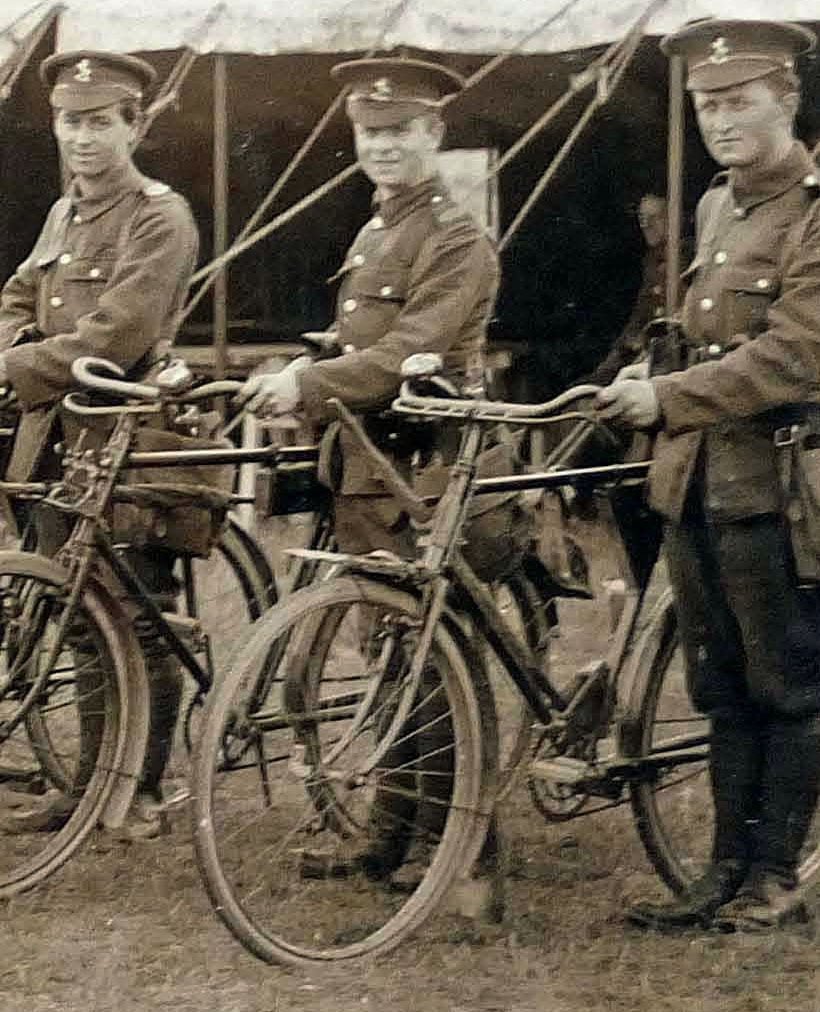
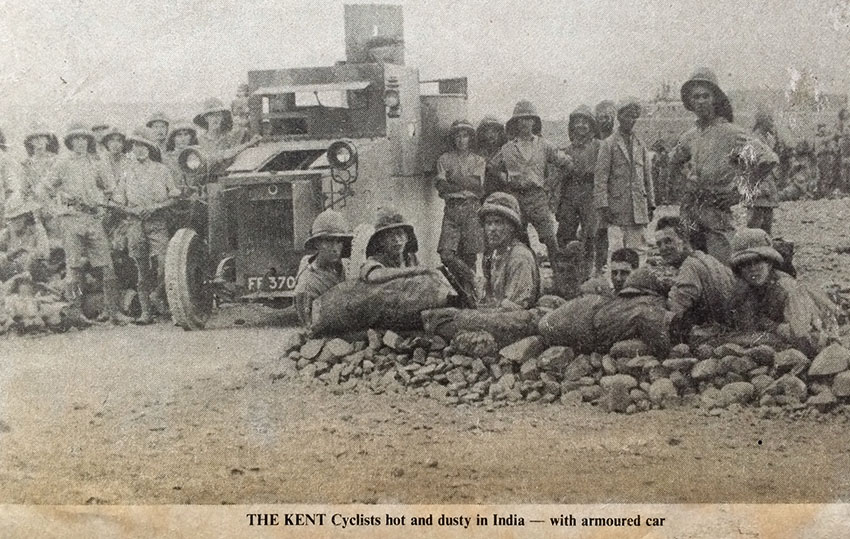












ARMSTRONG TRIPLEX 3-SPEED Co LTD
Armstrong Works, Icknield St, Birmingham

Sturmey Archer had not yet dominated the market in the early years of the 20th century, and there was considerable competition for 3-Speed gears. Armstrong was a major player in the field.
William Reilly invented the Tricoaster three-speed hub for Raleigh. Harry Reilly (William’s brother) set up Armstrong-Triplex Three-Speed Gear Co in 1906, using one of William’s discarded hub designs. Armstrong was Harry’s father-in-law. This caused a rift with the Bowdens of Raleigh, and William Reilly resigned from Raleigh in 1910.
New Hudson favoured the Armstrong gear. Armstrong Triplex was incorporated as a limited company in 1907, with their headquarters the St. George’s Engineering factory. Apparently, when St. George’s Engineering’s New Rapid Cycle Co got into financial difficulties, New Rapid was taken over by New Hudson.
In 1914 Raleigh bought the Armstrong-Triplex Three Speed Co from New Hudson for £6000.





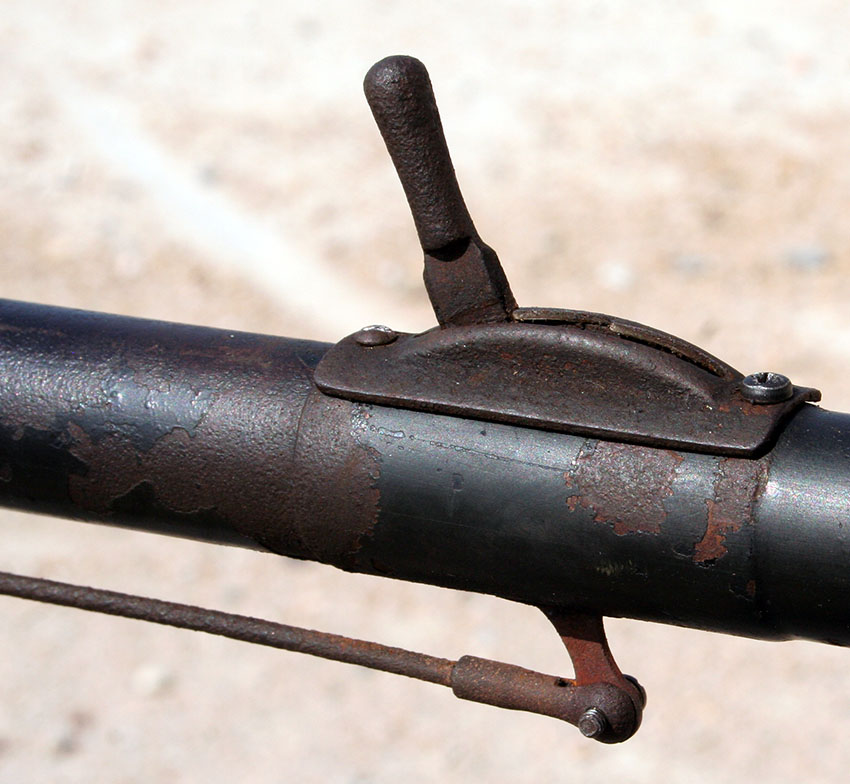





THE EAST AFRICA CAMPAIGN

GERMAN COMMANDER EMIL VON LETTOW-VORBECK
GERMAN EAST AFRICA comprised what is now Burundi, Rwanda and mainland Tanzania.
BRITISH EAST AFRICA subsequently became Kenya; Uganda was a separate British Protectorate.
The British and Germans maintained only nominal forces in East Africa prior to WW1, primarily to deal with border raids and local uprisings, and their troop numbers were more or less equal. Colonial powers initially considered it unwise for black Africans to fight white soldiers, but ‘Askari’ – native warriors – were duly incorporated into the German army and the British army subsequently raised black units too.
The British and German colonial governors were on good terms before the war and agreed to remain neutral in the event of war; the Congo Act of 1885 endorsed this policy.
But on 5th August, 1914, the British, using Ugandan troops, violated the Congo Act by attacking German river outposts on Lake Victoria. Three days later the British navy bombarded Dar-es-Salaam. In response, German commander Lt Col Paul Emil von Lettow-Vorbeck started raiding various locations in Uganda and British East Africa.
Lt Col Paul Emil von Lettow-Vorbeck’s essential purpose was to divert Allied resources from the Western Front to Africa. As a result, after initial pitched battles, subsequent German strategy mostly involved skirmishes, with German forces leading what in effect might be described as guerrilla warfare.

LOCAL RECRUITMENT

As well as combat troops, over one million locals were commandeered or employed by the different combatants as porters for food and equipment. This had a terrible impact on the African countries involved, as they were badly paid, given food that was of poor quality or entirely foreign to them and a high proportion got sick or died.
Not since the American War of Independence, when 14,000 slaves and freemen fought as black loyalists alongside the British, had such large numbers of Africans been involved in fighting for Europeans. The war exacerbated existing tensions, with various mutinies and uprisings: in Nyasaland (Malawi), American-trained missionary John Chilembwe led an anti-colonial uprising triggered by the forced military recruitment of Nyasas and the subsequent deaths of a high proportion of them in the first few weeks of he war fighting for the British (as the KAR – King’s African Rifles). There was also unrest in the Niger Delta, Yorubaland and British East Africa.
An armed rebellion took place in South Africa by Boers sympathetic to Germany, which was successfully put down by General Smuts, who went onto lead the Allied forces in Africa.
French colonies in Africa had introduced compulsory military service in 1912 for all African males. At the outbreak of war, 14,785 troops were raised in French West Africa, with a further 50,000 in 1915-16. French African troops were used for combat in Europe, the tirailleurs in charge of artillery, with their distinctive red fezes, were famous. Of the total 1,186,000 French troops killed or missing in action in WW1, 71,100 were from Algeria, Senegal, Morocco, Tunisia and Madagascar.
British and Allied troops were raised from Britain, India, British East Africa (Kenya), Uganda, Gold Coast (Ghana), Nigeria, West Indies, Congo, Belgium, Portugal, South Africa and Southern Rhodesia (Zimbabwe), as well as from the countries directly involved: Northern Rhodesia (Zambia), Nyasaland (Malawi), Portuguese East Africa (Mozambique) and Belgian Congo. Notable British black troops included the King’s African Rifles, West African Field Force and the Cape Corps (mixed-race soldiers from South Africa).
Great Britain introduced military conscription in British East Africa in 1915 for all males aged 18-45; this was extended to Uganda in April, 1917.

THE BATTLE OF THE BEES

COPY OF BATTLE MAP DRAWN BY LT-COL VON LETTOW-VORBECK
The British attempt to capture Tanga in 1914 – the Battle of Tanga, also known as the Battle of the Bees – was to become ‘one of the most notable failures in British military history.’ Great Britain called upon its second line Indian troops, and the 8000-strong Indian Expeditionary Force B landed in Tanga, German East Africa (Tanzania) on 2nd November 1914, commanded by Major-General Aitken.
Unfortunately, the troops were given little time to recover from their long sea journey, and were sent straight into battle after disembarkation on 3rd November. Although outnumbering the Germans by 8 to 1, they suffered a humiliating defeat. They were even attacked by swarms of wild bees during the invasion of the town. In their retreat, they abandoned nearly all their equipment …which was enough to arm and sustain the German force for at least a year.
…Early the next morning, November 4, the 6th Feldkompagnie fought skirmish actions between Tanga and the landing zone at Ras Kazone. Von Lettow-Vorbeck issued an order to move all available troops to the railway station in the center of Tanga. He realized that they would be at least partly protected against naval artillery by the houses of the European settlement stretching between the railway station and the harbor to the north. A medical staff officer at the Hospital building counted one British cruiser and nine transport ships in the harbor at that moment. [The actual count was two cruisers and 14 transports.]
The flat area towards Ras Kazone (on the right side of the map below) and also the southern part of Tanga consisted of dense coconut and rubber plantations, enclosed by hedges. As von Lettow-Vorbeck feared additional landings further south, he concentrated his reserves at his right (southern) flank, were they could also be used for a counterattack should the main battle take place between Tanga and Ras Kazone.
The British attack force was ready to move out by sunrise; however, Maj. Gen. Aitken sent word to all his units that a hearty breakfast was to be eaten by everyone. This order took up an essential two hours, during which time the invaders could have virtually walked into the city of Tanga. But the German forces were fully in place by 3:00 pm, when the British began their advance. Almost immediately, askari-manned machine guns opened up and inflicted casualties on the sick and exhausted Indian troops.
The fighting was very intense at the eastern outskirts of Tanga where the 6th Field Company was forced to retreat by the British North Lancashire regiment. The enemy reached the railway station and occupied part of the town when the remnants of the 6th Company reassembled and counterattacked using also the two European companies. A tough street fighting started as the newly arrived German companies tried to clear the enemy out in desperate house-to-house fighting.
Meanwhile the 16th and 17th Field Companies had engaged the enemy south of Tanga, but the askaris started to retreat after approximately one hour of firefights. Used to fighting tribal warriors, they had never been confronted with an enemy with such a degree of firepower. Some of the German staff officers intervened immediately in an attempt to stem the retreat. One German officer is mentioned furiously throwing an empty wine bottle at retreating German askaris, while others tried to appeal to the pride of the askaris or exposed themselves to enemy fire to show them that the enemy fire was not as deadly and accurate as they believed.
Von Lettow-Vorbeck realized that the situation had become critical and that the front would not hold much longer against the attacks of superior numbers. At the harbor the Kashmiri rifles’ battalion, supported by naval artillery, was about to outflank the German defenses. Von Lettow-Vorbeck threw the 13th Field Company into the battle. The company immediately performed a bayonet charge against the left flank of the Lancashire regiment, supported by the continuous fire of four machine guns.
Fortuitously for the Germans, the 4th Field Company arrived by railway moments after the 13th’s attack; the newly arrived 4th Company was immediately used to support the attack by the 13th Company. The flanking attack drove back the exhausted Indian troops, many men dropping their weapons and other equipment and heading for the beach. Witnessing the successful advance, the other German units along the frontline enthusiastically joined the attack, routing the British and Indian troops in close combat in the plantations. The machine guns were used against the retreating troops causing numerous casualties. Unexpectedly, the German troops were supported by a new ally: swarms of bees attacked when their hives were battered by machine gun bullets. [The bees attacked both sides in this battle. British newspapers tried to use the “Battle of the Bees” as an insidious German battle ploy.]
It was already getting dark and the situation became quite confused. It became even more confused when an askari musician played the wrong bugle call, which caused many of the native companies to pull back west of the town. Von Lettow-Vorbeck began rushing about the field, trying to reverse the erroneous orders. For several hours – until nearly dawn on November 5 – the city of Tanga was undefended; the British could have simply marched in and occupied the town. The German commander needn’t have bothered, as the demoralized British and Indian units had pulled back to the main invasion beach. At about 6:30 pm the firing had stopped, and the battle for Tanga was ended.
Disgusted by the poor performance of his cobbled-together Anglo-Indian force, Maj. Gen. Aitken ordered his men back to their transports. They were all back on their ships by November 5, when the flotilla sailed away. The British force had sustained 360 men killed, 487 wounded, and 148 missing or presumed captured.
By contrast, Lt. Col. von Lettow-Vorbeck was thrilled with the overall performance of his men, outnumbered nearly 8 to 1. German casualties totaled 16 Germans and 55 askaris killed and 76 Germans and askaris wounded.
In addition, the departing British and Indians abandoned large amounts of equipment, which the Germans promptly acquired. There were enough rifles for the Germans to rearm three companies with modern rifles (the askaris were using Mauser 1871 single-shot bolt-action rifles) along with 600,000 rounds of ammunition. They also found 16 machine guns, field telephones and enough uniforms to last a year.

SOUTH AFRICAN TROOPS
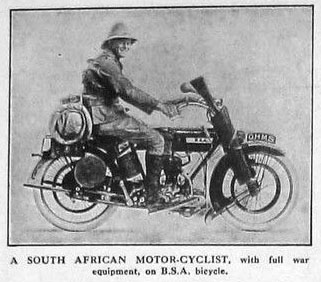
SOUTH AFRICAN MOTOR CYCLIST CORPS
In March 1916 South African reinforcements arrived under the command of J.C Smuts. He had his eye on capturing German territory to trade with Portugal for South African expansion, so he invaded German East Africa from the north and entered Dar-es-Salaam on 3rd September. Nevertheless, despite capturing territory, he had little impact against German troops. The South African troops also suffered badly from malaria and by 1917 were replaced by British black regiments of the West African Frontier Force and the King’s African Rifles. Smuts was recalled to London in January 1917 to hand over his command. Smuts had declared victory with his occupation of the German East African capital, so the War Office in London was confused when Allied shipping and troops continued to be bogged down in the East African war. In november, with a shortage of arms and rations, Lettow-Vorbeck’s troops moved into Portuguese territory where they stayed for the next year.
TO READ MORE ABOUT
THE SOUTH AFRICAN MOTOR CYCLE CORPS
PLEASE CLICK HERE

THE SS MENDI DISASTER
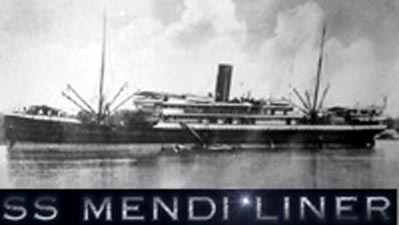
Black Africans were not permitted by the British to serve as front line troops in Europe, but many served in a subsidiary capacity. They were segregated while in Europe. A major tragedy occurred on 21st February, 1917, when 616 South Africans en route to France – members of the South African Native Labour Corps, and 607 of them black troops – plus 30 crew members drowned when their ship SS Mendi sank in the Solent. The SS Mendi had been almost cut in half by the SS Darro, an empty meat ship bound for Argentina. Lifeboats from HMS Brisk, a destroyer escorting the Mendi, was able to rescue over 200 survivors. There was considerable controversy over the incident as the captain of the Darro, Henry W. Stump, made no attempt to try and rescue survivors, and he was accused of racial prejudice at his trial.
Only the white officers on board the Mendi were decorated after the war; none of the black servicemen, survivors or the dead, received a medal, as a consequence of a South African government decision. Although black recruits from neighbouring British protectorates received British medals after the war, members of the South African Native Labour Corps received none, and relatives of the Mendi received no compensation, apology, or even formal notification.
In contrast, when von Lettow-Vorbeck’s forces surrendered, he issued written certificates to his men, promising that the German government would give them their back pay. In the year of his death, the West German parliament voted to deliver back pay to all surviving Askaris. A temporary cashier’s office was set up in Mwanza on Lake Victoria. Of the 350 veterans who gathered, only a handful could produce the certificates that von Lettow-Vorbeck had given them in 1918. Others presented pieces of their old uniforms as proof of service. The German banker who had brought the money came up with an idea. As each claimant stepped forward, he was handed a broom and ordered in German to perform the manual of arms. Not one man failed the test.

GERMAN SURRENDER: TWO WEEKS AFTER ARMISTICE

ILLUSTRATION OF GERMAN SURRENDER, BY ANONYMOUS AFRICAN ARTIST
This theatre of war is little known a century later, but is interesting for the success of von Lettow-Vorbeck in tying up Allied troops that otherwise could have been used elsewhere. Disease killed very many more combatants than bullets. But Lettow-Vorbeck was a brilliant commander, never lost a battle, and remained undefeated when he eventually surrendered to the British two weeks after the 1918 Armistice.
A humorous incident was related by General von Lettow-Vorbeck regarding a member of the S.A.M.C.C. riding a B.S.A. On the 13th November, 1918. The hapless dispatch rider was taking a message about the Armistice to a Kings African Rifles battalion on his motor cycle. He couldn’t find the unit and rode right past the British lines and into German hands. His captors were most surprised that he had managed to get through the lines, as they had laid mines all along the road. They were even more surprised when they read the message he was carrying …as they had not previously been notified that the war in Europe was finally over.

* This text with thanks to Canterbury Times, reprinted by permission – http://www.canterburytimes.co.uk/David-Lewis-Cycling-King/story-21215879-detail/story.html
Kent Cyclist Battalion photos with thanks to Kathy Bailes at the Canterbury Times
Click to access KENT%20CYCLISTS.pdf
http://alshaw.blogspot.co.uk/2007/12/african-soldiers-in-world-war-one.html
http://en.wikipedia.org/wiki/SS_Mendi and http://www.independent.co.uk/news/uk/this-britain/they-died-like-warriors-tale-of-the-ss-mendi-458151.html
http://burnpit.legion.org/2013/11/battle-tanga-british-invasion-german-east-africa-defeated-assisted-encounters-african-bees
http://burnpit.legion.org/2013/11/battle-tanga-british-invasion-german-east-africa-defeated-assisted-encounters-african-bees
http://www.bsa.org.nz/index.php/stories/b-s-a-in-german-east-africa


















































